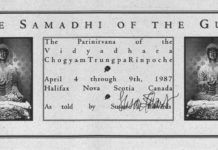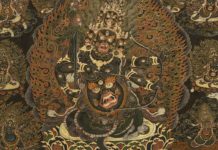Director of Shambhala Europe, Chris Tamdjidi, discusses the importance of relating to earth in terms of establishing a good container for the teachings, his views on the differences between the Shambhala sangha in Europe and North America, and the importance of loyalty to the Sakyong. He also talks about several innovative programs that are taking place under the auspices of Shambhala Europe on contemplative psycology, healing, and the arts.
Listeners’ Comments
Dear Chronicles,
Maybe I’m just getting old, but I was confused by what Acharya Adam Lobel said about Sakyong Mipham seeing his role as stabilizing the Druk Sakyong’s teachings. It’s hard to see how dissolving the traditions and forms that Trungpa Rinpoche established can be regarded as a stabilizing influence. If Sakyong Mipham feels the need to depart from the traditions and vision that his father established, I guess that’s up to him. But to call this departure a stabilization seems misleading. Why the spin?
As one of those students who is not “keeping up” with Sakyong Mipham’s new direction and teachings, I have to wonder how he intends to “unify” all of us. There are many people, like myself, who have a deep heart connection with Trungpa Rinpoche, whose lives have been and continue to be shaped by his teachings and empowerments, who hold his transmissions and feel a duty to understand, practice, and pass them on, and who find little or no connection between SMR’s Shambhala Buddhism and his father’s vast and profound vision. Is there a place for us in the “big tent”? Is this still our sangha? Or are we ronin warriors cast out to find a new tent where we can practice the Vidyadhara’s teachings as they were given?
Some of Trungpa Rinpoche’s loyal students are dedicating their lives to preserving and furthering their teacher’s legacy, and interestingly enough doing so without the support of Shambhala International. I guess it’s up to all of us to exercise our prajna and decide which efforts best serve the Druk Sakyong’s vision.
Thanks again, everyone at the Chronicles, for providing us with spicy food to chew on.
With love,
Suzanne Duarte
Amsterdam
* * *
RE: Rabin and Lobel interviews
I agree with the sentiment expressed in Suzanne Duarte’s letter. Sakyong Mipham has every right, even duty, to promulgate his own teachings. They are rooted in part in his father’s teachings, and perhaps to an even greater extent in those of Penor Rinpoche. Ultimately they stand on their own and on the genuineness of his being. However, to state that the Sakyong’s dharma is identical with that of the Druk Sakyong is a bit disingenuous. This would be a minor issue if so saying did not also obscure the transmission that Chogyam Trungpa worked so hard to provide.
This is especially true of the Shambhala teachings, which CTR said had their own independent basis, and apply “to people of any faith, not just people who believe in Buddhism”. Shambhala Buddhism is great for Buddhists, but it is more circumscribed than the “without credentials” vision of Shambhala and of a Shambhala kingdom that “should have lots of spiritual disciplines in it”. I’m surprised that Adam Lobel did not address this, and that it in fact has been skirted by all the interviewees.
In the gap in the tapes 🙂 ,
Mark Szpakowski
Halifax
* * *
Dear Chronicles
Thanks for the interesting and inspiring interviews with Adam Lobel and Chris Tamdjidi. I would like to respond to the feedback by Suzanne Duarte and Mark Szpakowski, if I may. As a relatively new member (since the year 2000) of the Shambhala sangha I am very intrigued by the debate on the differences in vision between Chögyam Trungpa Rinpoche and the Sakyong. Maybe I can not see clearly what the debate is about, since I was neither a meditator nor a sangha member when Trungpa was still alive. As Suzanne Duarte said, I guess we all have to exercise our prajna.
Preserving the teachings and being open to people of all faiths seem very worthy goals, a spiritual discipline if you like. But saying that the Shambhala teachings are non-sectarian or secular, as Mark Szpakowski wrote, is maybe not entirely true. At Warrior Assembly, the chants that are then presented are clearly inspired by Tibetan culture and Tibetan buddhist teachings. If I were not have been a buddhist at the time, and if I would have attended Shambhala training because it is secular, I would or could have been insulted or at least unpleasantly surprised to find out that no other religions are referred to or acknowledged in the Shambhala chants, except in Buddhist and Tibetan/Oriental terms. It seems more accurate to say “Shambhala Buddhist”, people will generally know what kind of thing they get into. This should certainly simultaneously imply that it is our discipline as genuine followers of a spiritual path to be open and inquisitive to the world, since no one is immune to cocoon-inclined behaviour. And it does not imply any superiority of Buddhism or Shambhala (Buddhism) over any other lineage or faith.
Another thing that surprises me, is that some people feel that the Sakyong is not preserving the teachings in a way that his father intended to be done by him. I do not know if this sounds too simple or naive, but so far I have not felt or seen any contradiction in what I have read in transcripts by VCTR and the Sakyong. Certainly, there is a great difference in style and also in form, but underlying it all is the same vision: liberation from ego, working towards enlightenment for all beings, by cultivating wakefulness, bodhichitta, fearlessness. I guess we all have to find our own way to cultivate these things, by following the teacher and/or lineage that best suits us, inspires us and helps us to become human beings with good head and shoulders and a genuine heart of tender sadness 🙂
Warm dharma wishes, Ans de Vries, Amsterdam











